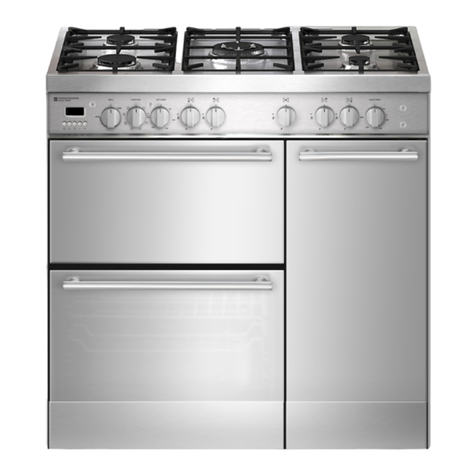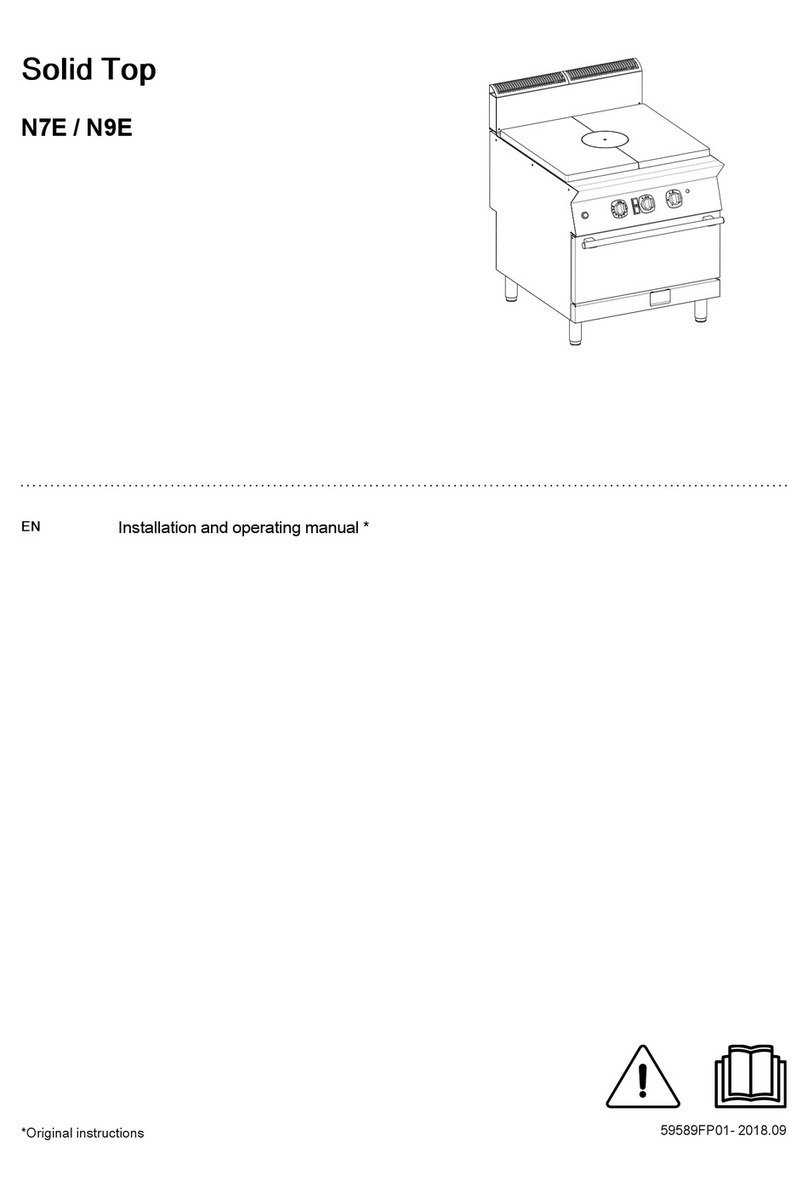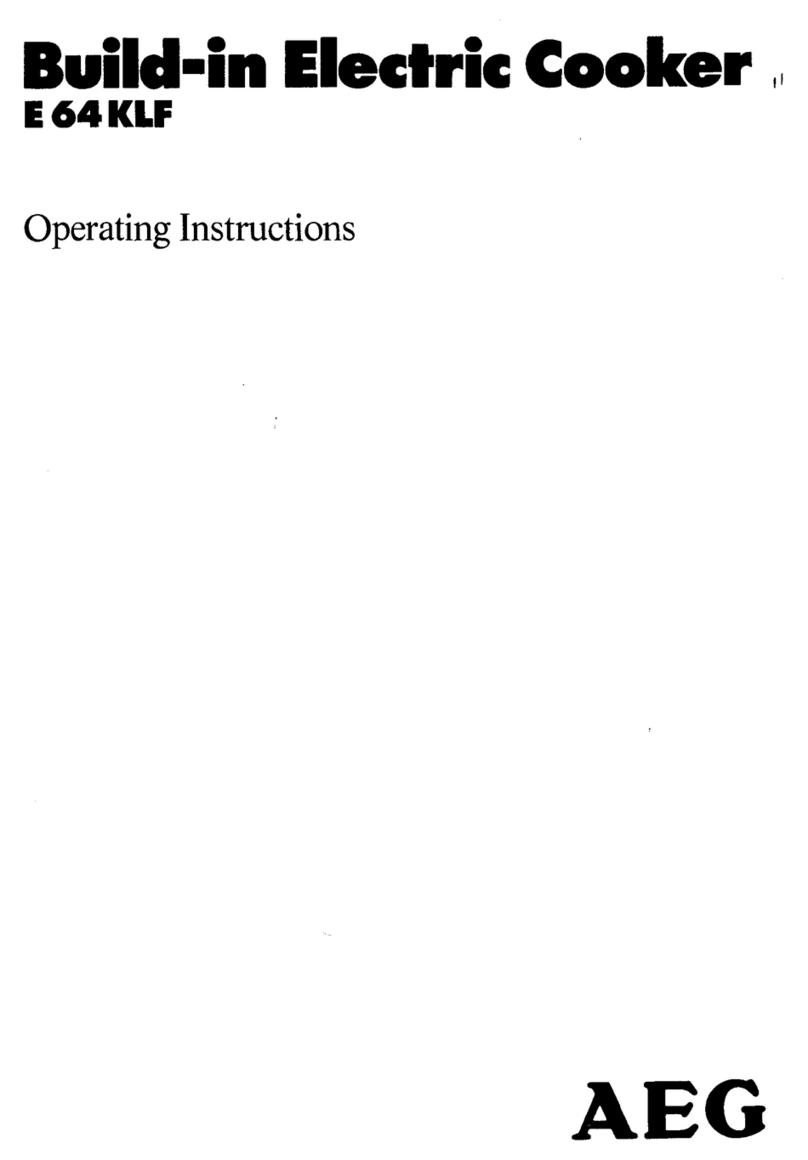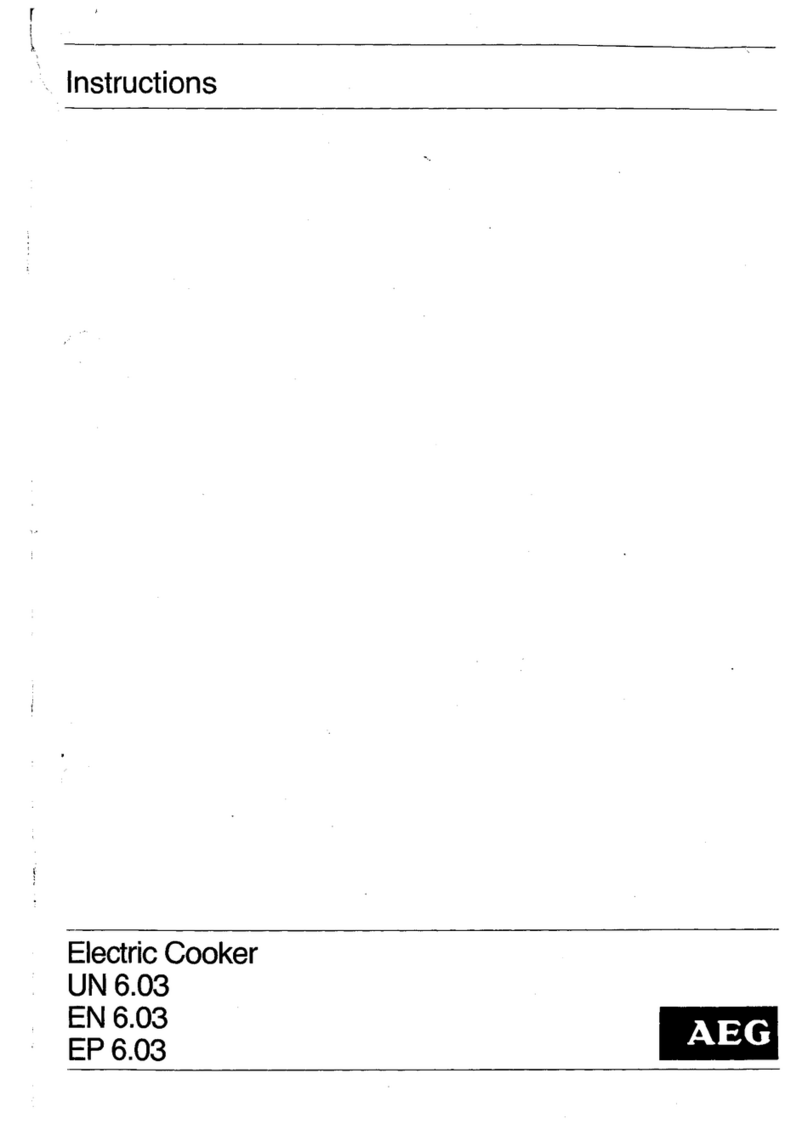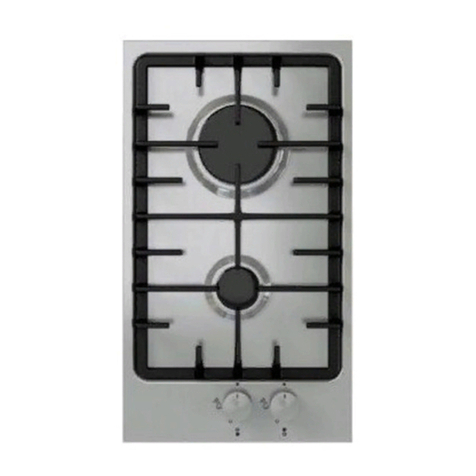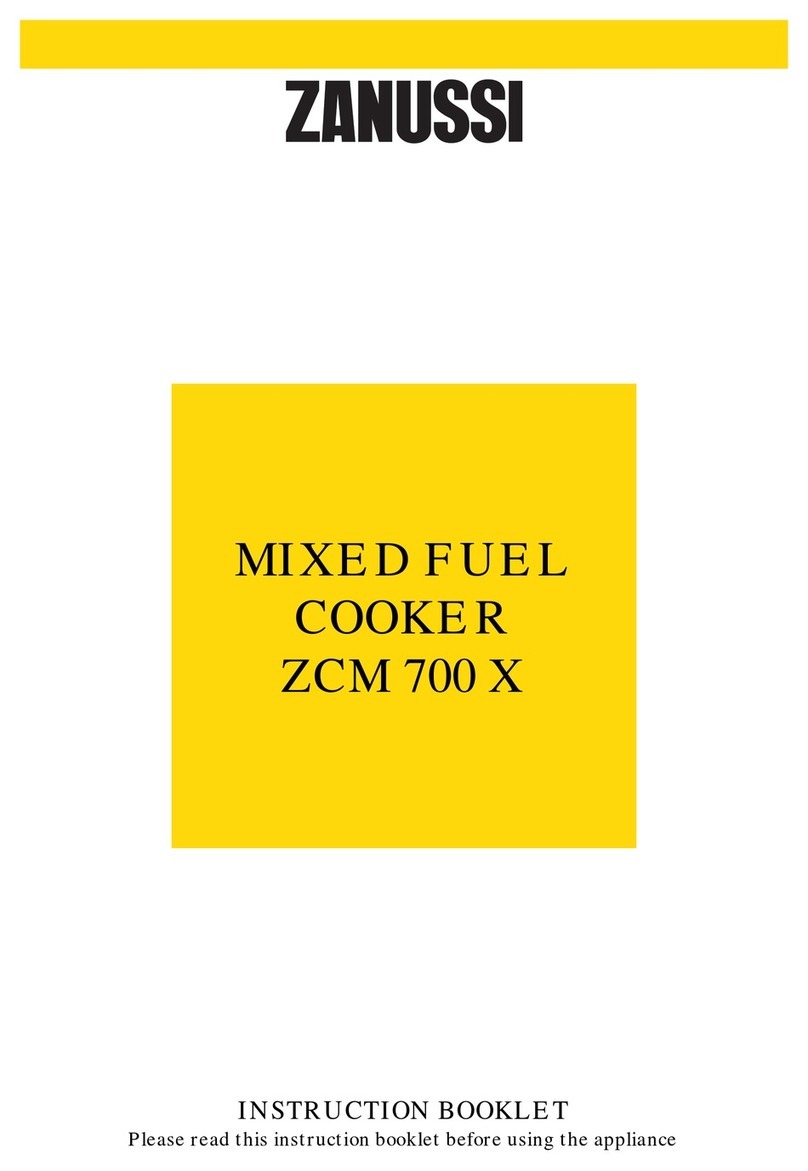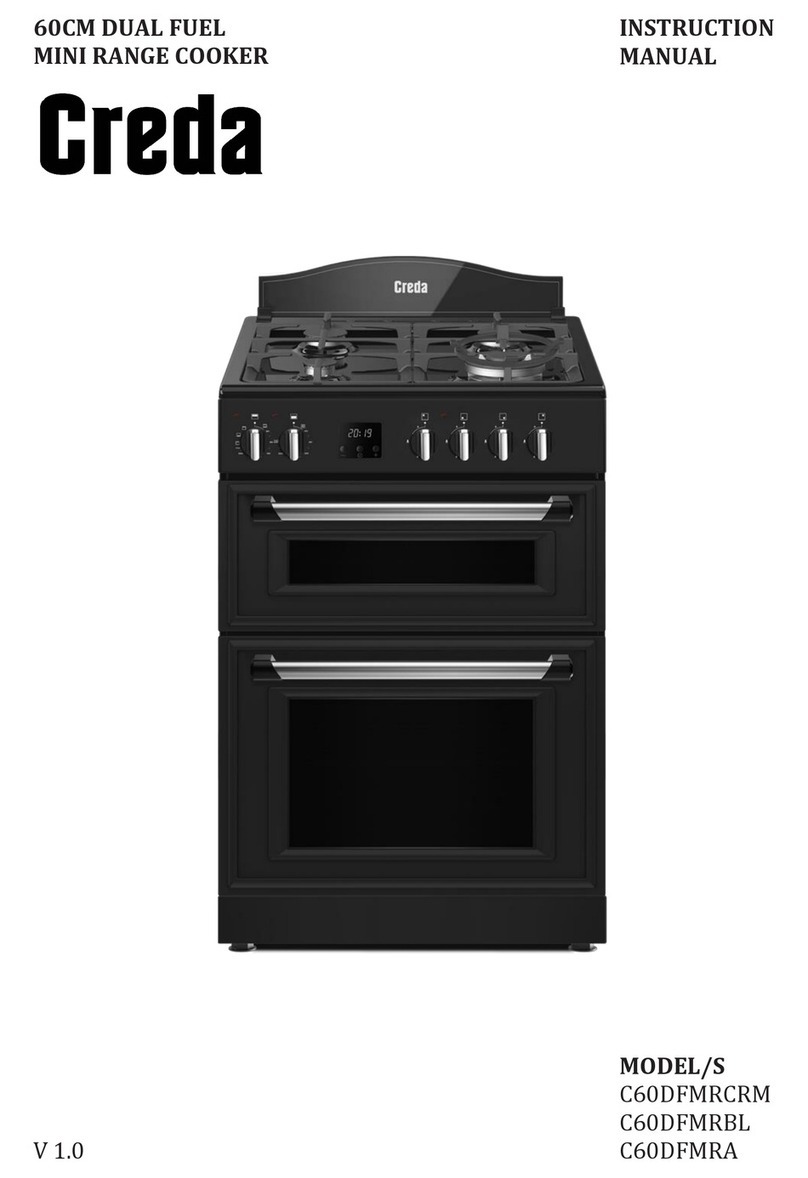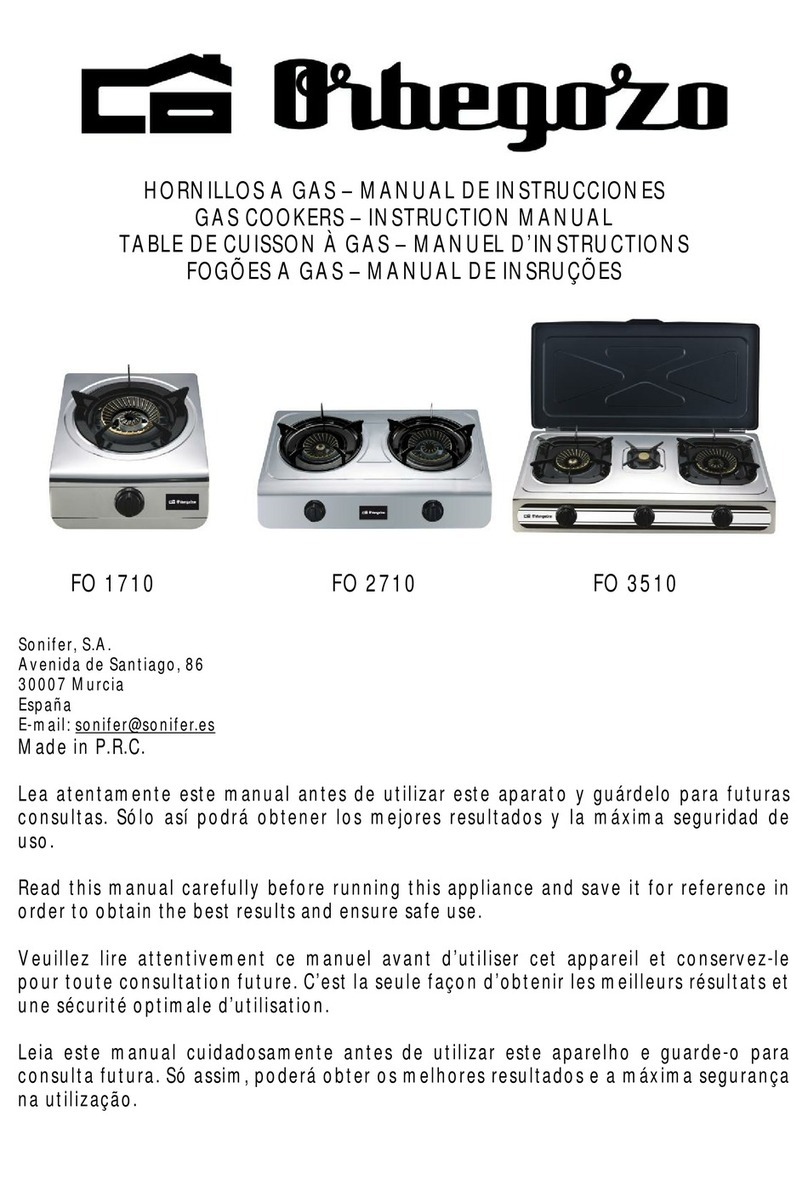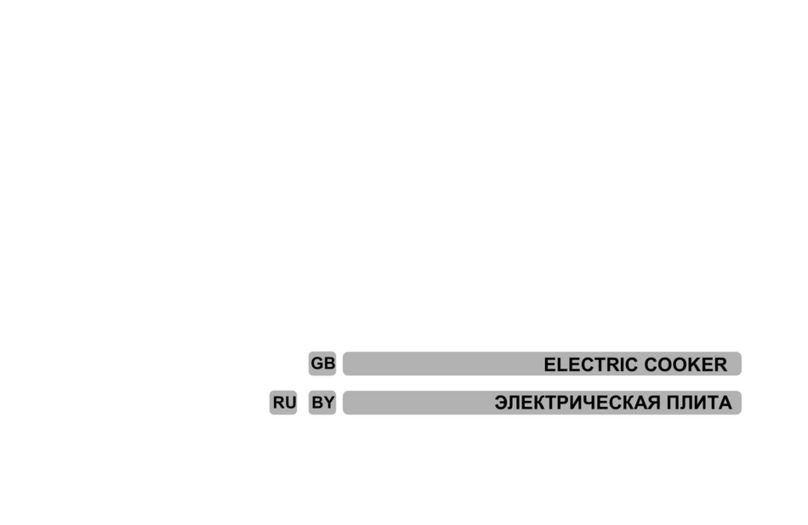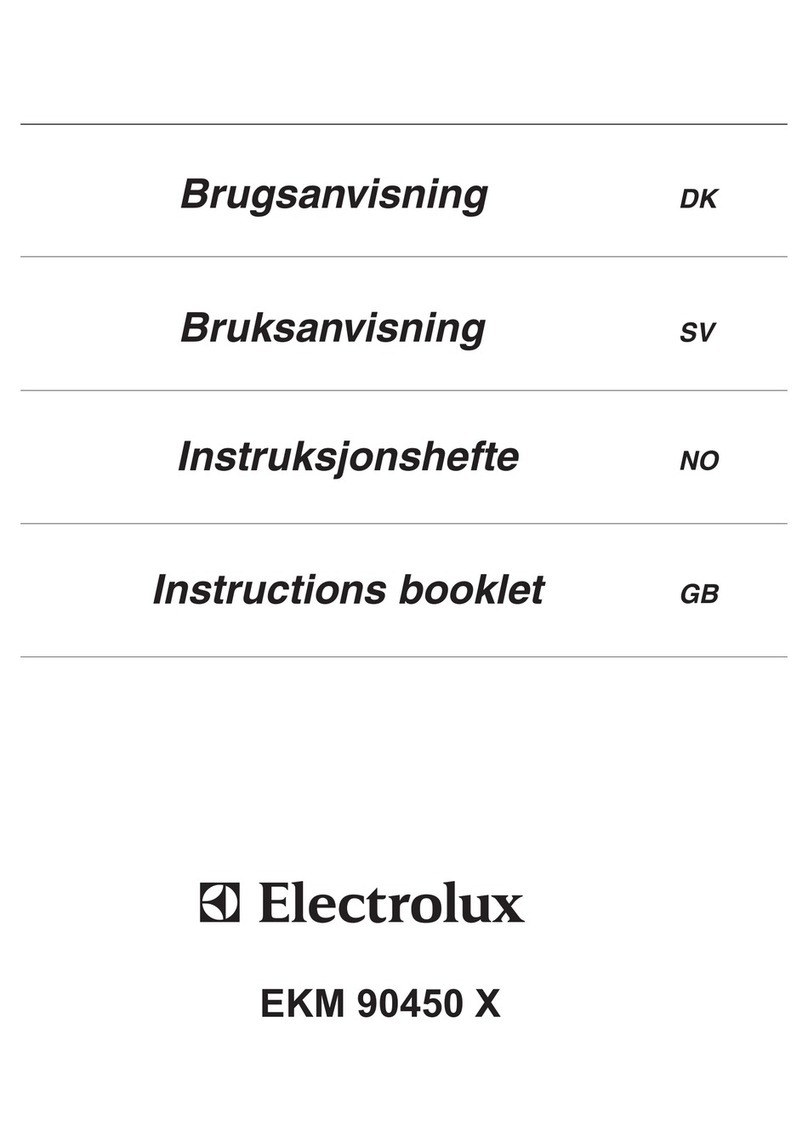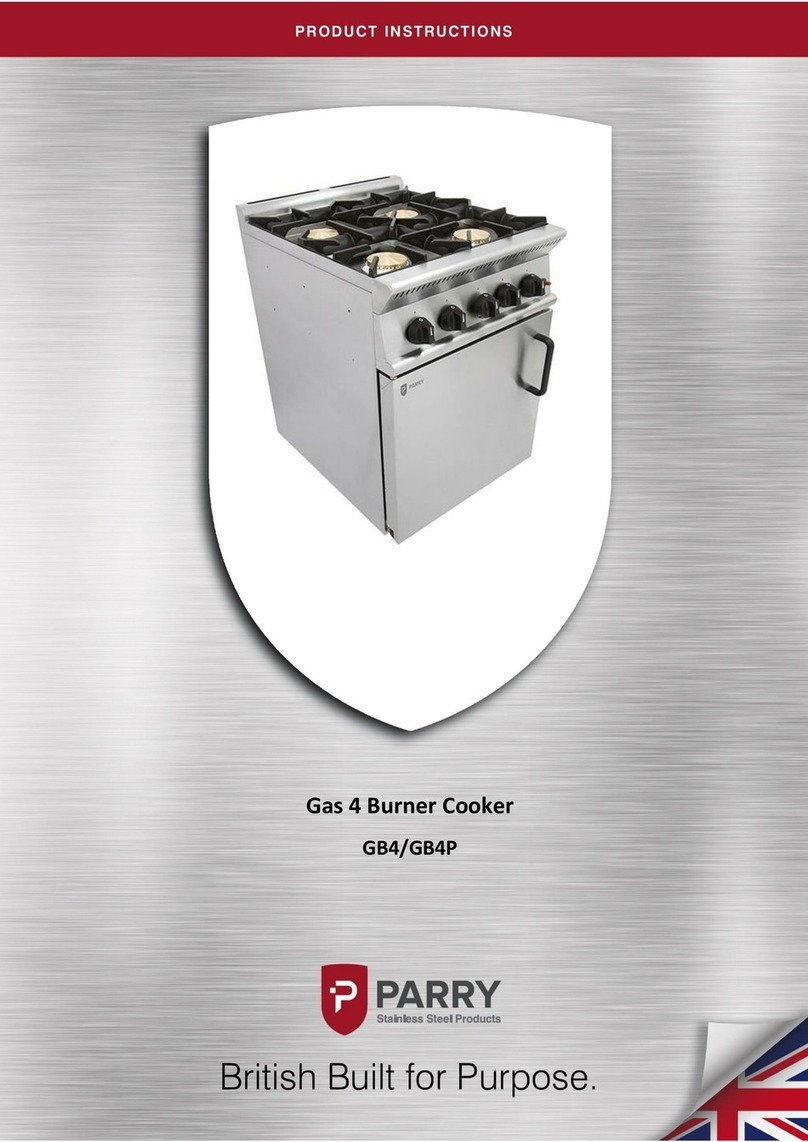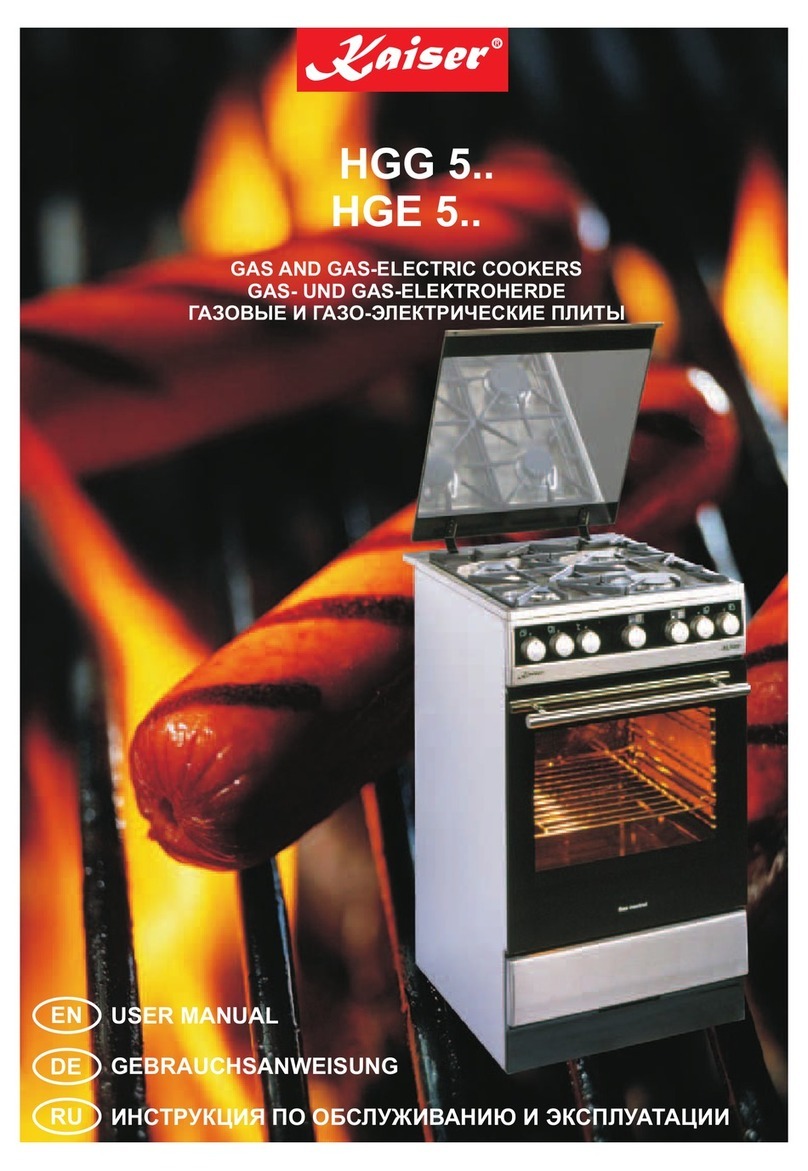BigBlue RANGECOOKERS Select 100df Mounting instructions

INSTALLATION INSTRUCTIONS AND USER GUIDE
Select 100df
ISSUE B

2
Important:
This appliance is designed and manufactured solely for the cooking of domestic
(household) food and is not suitable for any non domestic application and therefore
should not be used in a commercial environment.
The appliance guarantee will be void if the appliance is used within a non domestic
environment i.e. a semi commercial, commercial or communal environment.
Dear Customer,
Thank you for having purchased and given your preference to our product.
The safety precautions and recommendations reported below are for your own safety
and that of others. They will also provide a means by which to make full use of the
features offered by your appliance.
Please preserve this booklet carefully. It may be useful in future, either to yourself or
to others in the event that doubts should arise relating to its operation.
This appliance must be used only for the task it has explicitly been designed for,
that is for cooking foodstuffs. Any other form of usage is to be considered as
inappropriate and therefore dangerous.
The manufacturer declines all responsibility in the event of damage caused by
improper, incorrect or illogical use of the appliance.
Introduction

3
IMPORTANT INFORMATION FOR CORRECT DISPOSAL OF THE PRODUCT IN
ACCORDANCE WITH EC DIRECTIVE 2002/96/EC.
At the end of its working life, the product must not be disposed of as
urban waste. It must be taken to a special local authority differentiated
waste collection centre or to a dealer providing this service.
Disposing of a household appliance separately avoids possible nega-
tive consequences for the environment and health deriving from inap-
propriate disposal and enables the constituent materials to be recov-
ered to obtain significant savings in energy and resources. As a
reminder of the need to dispose of household appliances separately,
the product is marked with a crossed-out wheeled dustbin.
IMPORTANT INSTRUCTIONS AND ADVICE FOR THE USE OF ELECTRICAL
APPLIANCES
The use of any electrical appliance requires the compliance with some basic rules,
namely:
– do not touch the appliance with wet or damp hands (or feet)
– do not use the appliance whilst in bare feet
– do not allow the appliance to be operated by children or unqualified persons without
supervision.
The manufacturer cannot be deemed responsible for damages caused by wrong or
incorrect use.
DECLARATION OF CE CONFORMITY
•
This cooker has been designed, constructed and marketed in compliance with:
- Safety requirements of EU Directive "Gas" 2009/142/EC;
- Safety requirements of EU Directive "Low Voltage" 2006/95/EC;
- Protection requirements of EU Directive "EMC" 2004/108/EC;
- Requirements of EU Directive 93/68/EEC.
GB

4
IMPORTANT SAFEGUARDS AND RECOMMENDATIONS
After having unpacked the appliance, check to ensure that it is not damaged.
In case of doubt, do not use it and consult your supplier or a professionally qualified
technician.
Packing elements (i.e. plastic bags, polystyrene foam, nails, packing straps, etc.) should
not be left around within easy reach of children, as these may cause serious injuries.
•ATTENTION: please peel plastic cover off both sides and front of the cooker before
use.
• Do not attempt to modify the technical characteristics of the appliance as this may
cause danger to users.
• Do not carry out any cleaning or maintenance operations on the appliance without first
disconnecting it from the electric power supply.
• If you should decide not to use this appliance any longer (or decide to substitute an
older model), before disposing of it, it is recommended that it is made inoperative in an
appropriate manner in accordance to health and environmental protection regulations,
ensuring in particular that all potentially hazardous parts be made harmless, especially
in relation to children who could play with unused appliances.
• After use, always ensure that the control knobs are in the off position.
• Household appliances are not intended to be played with by children.
• Keep children away from the oven during use.
• Children, or persons with a disability which limits their ability to use the appliance,
should have a responsible person to instruct them in its use. The instructor should be
satisfied that they can use the appliance without danger to themselves or their sur-
roundings.
• During and after use of the cooker, certain parts will become very hot. Do not touch hot
parts.
• Some appliances are supplied with a protective film on steel and aluminium parts.
This film must be removed before using the appliance.
•WARNING
When correctly installed, your product meets all safety requirements laid down for
this type of product category. However special care should be taken around the
rear or the underneath of the appliance as these areas are not designed or
intended to be touched and may contain sharp or rough edges, that may cause
injury.
•Fire risk! Do not store flammable material in the ovens or in the storage compart-
ment.
• Make sure that electrical cords connecting other appliances in the proximity of
the cooker cannot come into contact with the hob or become entrapped in the
oven door.
• Do not line the oven walls with aluminium foil. Do not place baking trays or the
drip tray on the base of the oven chamber.

5
• The manufacturer declines all liability for injury to persons or damage to property
caused by incorrect or improper use of the appliance.
• The various components of the appliance are recyclable. Dispose of them in
accordance with the regulations in force in your country. If the appliance is to be
scrapped, remove the power cord.
• Always use oven gloves when removing the shelves and food trays from the oven
whilst hot.
• Do not hang towels, dishcloths or other items on the cooker or its handle – as
this could be a fire hazard.
• Clean the oven regularly and do not allow fat or oils to build up in the oven base
or trays. Remove spillages as soon as they occur.
• Do not stand on the cooker or on the open oven door.
• Always stand back from the cooker when opening the oven door to allow steam
and hot air to escape before removing the food.
• This appliance is for domestic use only.
•WARNING: Taking care NOT to lift the cooker by the door handles.
•Safe food handling: leave food in the oven for as short a time as possible before
and after cooking. This is to avoid contamination by organisms which may cause
food poisoning. Take particular care during warmer weather.
• Do not operate your appliance by means of an external timer or separate remote-
control system.

6
Fig. 1.1
GAS BURNERS
1. Auxiliary burner (A) 1,00 kW
2. Semi-rapid burner (SR) 1,75 kW
3. Rapid burner (R) 3,00 kW
4. Triple-ring burner (TR) 3,50 kW
Important Notes:
The electric ignition is incorporated in the knobs.
The appliance has a safety valve system fitted, the flow of gas will be stopped if and
when the flame should accidentally go out.
Cooking Hob
1
2
4
2
1
3

7
CONTROL PANEL - Controls description
1. Electronic programmer (main left oven only)
2. Multifunction main oven thermostat knob (left oven)
3. Multifunction main oven switch knob (left oven)
4. Front left burner control knob
5. Rear left burner control knob
6. Central burner control knob
7. Rear right burner control knob
8. Front right burner control knob
9. Conventional oven switch knob (right oven)
10. Conventional oven thermostat knob (right oven)
Pilot lamps:
11. Main oven thermostat indicator light (left oven)
12. Conventional oven thermostat indicator light (right oven)
Please note: This appliance incorporates a safety cooling fan which you will hear
operating whenever the oven or grill are in use. This fan is to reduce the external
temperature of the appliance and cool the internal components.
TEMPERATURE
Select 100df
RANGECOOKERS
MULTIFUNCTION TEMPERATURE
FUNCTION
A
U
T
O
P
1 2 4 5 7 8 9 10
3
11 12
Fig. 2.1
6
Control Panel
2

8
The electronic programmer is a device that groups together the following functions:
– 24 hour clock with illuminated display
– Timer (up to 23 hours and 59 minutes)
– Programme for automatic oven cooking
– Programme for semi-automatic oven cooking.
A
U
T
O
Description of the lighted symbols:
AUTO -flashing - Programmer in auto-
matic position but not pro-
grammed
AUTO -always lighted - Programmer in
automatic position with pro-
gramme inserted.
Automatic cooking taking place
Timer in operation
and AUTO - flashing - Programme
error.
(The time of day lies between the
calculated cooking start and end
time).
Note: Select a function by the respective
button and, in 5 seconds, set the
required time with the / buttons
(“one-hand” operation).
A power cut zeroes the clock and can-
cels the set programmes.
Description of the buttons:
Timer
Cooking time
End of cooking time
Manual position and cancellation of
the inserted cooking programme
Advancement of the numbers of all
programmes
Turning back of the numbers of all
programmes and changing the fre-
quency of the audible signal.
Fig. 3.2
Fig. 3.1
(main left oven only)
Electronic Programmer
3

9
ELECTRONIC CLOCK (fig. 3.2)
The programmer is equipped with an
electronic clock with lighted numbers
which indicate hours and minutes.
Upon immediate connection of the oven
or after a blackout, three zeroes will
flash on the programmer panel.
To set the hour it is necessary to push
the button and then the or
button until you have set the exact hour
(fig. 3.2).
Alternatively, simultaneously push the
two buttons and at the same
time push the or button.
Note: Setting the clock deletes any
programme.
ELECTRONIC TIMER
The timer programme consists only of a
buzzer which may be set for a maximum
period of 23 hours and 59 minutes.
If the AUTO is flashing push the
button.
To set the time, push the button and
the or until you obtain the
desired time (fig. 3.4).
Having finished the setting, the normal
time will appear on the panel and the
symbol will appear.
The countdown will start immediately and
may be seen at any moment on the panel
by simply pressing the button .
At the end of the time, the symbol
will be switched off and an intermittent
buzzer will go off; this can be stopped
by pressing any one of the buttons.
ALTERING THE AUDIBLE SIGNAL
By pressing the button you can
choose from three variations.
NORMAL COOKING WITHOUT THE
USE OF THE PROGRAMMER
To manually use the oven, that is, without
the aid of the programmer, it is necessary
to cancel the flashing AUTO by pushing
the button (AUTO will be switched off
and the symbol will go on - Fig. 3.3).
Attention: If the
AUTO
is not flashing
(which means a cooking programme has
already been inserted), by pushing the but-
ton you have cancelled the programme
and switched to manual.
Fig. 3.4
Fig. 3.3

10
A
U
T
O
A
U
T
O
AUTOMATIC OVEN COOKING
To cook food automatically in the oven,
it is necessary to:
1.Set the length of the cooking time
2.Set the end of the cooking time
3.Set the temperature and the oven
cooking programme.
These operations are done in the follow-
ing way:
1. Set the length of the cooking time by
pushing the button and the but-
ton to
advance, or to go back if
you have passed the desired time (fig.
3.5). The AUTO and the symbol
will be on.
2.Set the end of the cooking time by
pressing the button (the cooking
time already added to the clock time
will appear), and the button (fig.
3.6); if you pass the desired time you
may get back by pushing the but-
ton.
After this setting, the symbol will
go off. If after this setting, the AUTO
flashes on the panel and a buzzer
goes off, it means there was an error
in the programming.
In this case, modify the end of cook-
ing time or the cooking time itself by
following the above instructions
again.
3.Set the temperature and the cooking
programme by using the switch and
thermostat knobs of the oven (see
specific chapters).
Now the oven is programmed and
everything will work automatically, that
is the oven will turn on at the right
moment to end the cooking at the
established time.
During cooking, the symbol remains
on.
By pushing the button you can see
the time that remains until the end of
cooking.
The cooking programme may be can-
celled in any moment by pushing .
At the end of the cooking time the oven
will turn off automatically, the sym-
bol will turn off, AUTO will flash and a
buzzer will sound, which can be turned
off by pushing any of the buttons.
Turn the switch and thermostat knobs to
zero and put the programmer onto
“manual” by pressing the button.
Attention: A power cut makes the clock
go to zero and cancels the set pro-
grammes.
After a power cut three zeroes will flash
on the panel.
Fig. 3.6
Fig. 3.5

11
A
U
T
O
A
U
T
O
SEMI-AUTOMATIC COOKING
This is used to automatically switch off
the oven after the desired cooking time
has elapsed.
There are two ways to set your oven:
1. Set the length of the cooking time by
pushing the button and the
button to advance, or to go back-
wards if you have passed the desired
time (Fig. 3.7).
or
2. Set the end of the cooking time by
pushing the button and the
button to advance, or to go back-
wards if you have passed the desired
time (Fig. 3.8).
AUTO and the symbol will be on.
Then set the temperature and the
cooking programme using the oven
switch and thermostat knobs (see
specific chapters).
The oven is switched on and it will be
switched off automatically at the end
of the desired time.
During cooking, the symbol
remains on and by pressing the but-
ton you can see the time that
remains till the end of the cooking.
The cooking programme can be can-
celled at any moment by pushing the
button.
At the end of cooking, the oven and the
symbol will turn off, the AUTO will
flash and a buzzer will sound; that can
be stopped by pushing any of the but-
tons.
Turn the switch and thermostat knobs to
zero and put the programmer onto
“manual” by pressing the button.
Fig. 3.8
Fig. 3.7

12
Fig. 4.1
HOB BURNERS
Each hob burner is controlled by a separate gas tap
operated by a control knob (fig. 4.1) which has 3
positions marked on the control panel, these are:
– Symbol 0: tap closed (burner off)
– Symbol : High (maximum)
– Symbol : Low (minimum)
Push in and turn the knob anti-clockwise to the
selected position.
The maximum aperture position permits rapid boiling of liquids, whereas the minimum
aperture position allows slower warming of food or maintaining boiling conditions of
liquids.
To reduce the gas flow to minimum, rotate the knob further anti-clockwise to point the
indicator towards the small flame symbol.
Other intermediate operating adjustments can be achieved by positioning the indicator
between the maximum and minimum aperture positions, not between the maximum
aperture and closed positions.
N.B. When the hob is not being used, set the gas knobs to their closed positions and
also close the cock valve on the gas bottle or the main gas supply line.
How to use the Hob Burners
4
LIGHTING THE BURNERS
To ignite the burner, the following instructions are to be followed:
1)
Press in the corresponding knob and turn counter-clockwise to the full flame position
marked by the symbol (fig. 4.1) and hold the knob in until the flame has been lit.
In the case of a mains failure light the burner with a match or lighted taper.
2) Wait about ten seconds after the gas lighting before releasing the knob (starting time
for the valve).
3) Adjust the gas valve to the desired power.
Important
If the burner flame should go out for some reason, the safety valve will automatically
stop the gas flow.
To re-light the burner, return the knob to the closed 0position, wait for at least 1 minute
and then repeat the lighting procedure.
If your local gas supply makes it difficult to light the burner with the knob set to maxi-
mum, set the knob to minimum and repeat the operation.

13
CHOICE OF THE BURNER
On the control panel, near each knob, there is a diagram that indicates which burner is
controlled by that knob.
Select the burner that is most suitable for the diameter and capacity of the pan to be
used.
As an indication, the burners and the pans must be used in the following way:
It is important that the base diameter of the pot is at least the same diameter as the
burner ring to obtain an efficient heat transfer.
Always position pans centrally over the burners.
Adjust the size of the flame so that it does not lick up the side of the pan.
Position pan handles so that they cannot be accidentally knocked.
Fig. 4.2
BURNERS POT DIAMETER
Auxiliary 12 - 14 cm
Semi-rapid 16 - 24 cm
Rapid 24 - 26 cm
Triple-ring 26 - 28 cm
do not use pans with concave or convex bases
CORRECT USE OF TRIPLE-RING BURNER (Figs. 4.3a - 4.3b)
Flat-bottomed pans should be placed directly onto the pan-support.
When using a WOK always place the supplied stand in position over the burner to main-
tain the correct operation of the triple-ring burner (Fig. 4.3b).
IMPORTANT:
The special grille for wok pans (fig. 4.3b) MUST BE PLACED ONLY over the pan-rest for
the triple-ring burner.
Wok max 36 cm
Fig. 4.3a Fig. 4.3b
WRONG CORRECT

14
Attention: the oven door becomes
very hot during operation. Keep chil-
dren away.
OPERATING PRINCIPLES
Heating and cooking in the MULTI-
FUNCTION oven are obtained in the fol-
lowing ways:
a. by normal convection
The heat is produced by the upper
and lower heating elements.
b. by forced convection
The fan draws in air contained within
the oven housing at the rear of the
oven and forces it over the circular
heating element. The hot air envelops
the food in the oven giving faster and
more even cooking before it is drawn
back into the housing to repeat the
cycle. It is possible to cook several
dishes simultaneously due to the
even distribution of heat within the
oven.
c. by forced semi-convection
The heat produced by the top and
bottom heating elements is distrib-
uted throughout the oven by the fan.
d. by radiant heat
The food is grilled by the infra red
grill element.
e. by radiant heat and ventilation
The food is grilled by the grill ele-
ment, heat is distributed throughout
the oven.
f. by ventilation
The food is defrosted by using the
fan only function without heat.
GENERAL FEATURES
As its name indicates, this is an oven
that presents particular features from an
operational point of view.
In fact, it is possible to insert 7 different
programs to satisfy every cooking need.
The 7 positions, thermostatically con-
trolled, are obtained by 4 heating ele-
ments which are:
– Bottom element 1200 W
– Top element 1000 W
– Grill element 2000 W
– Circular element 2200 W
NOTE: Upon first use, it is advisable to
operate the oven for 30 minutes in the
position and for another 30 minutes
at the maximum temperature (thermo-
stat knob on position 250) in the posi-
tions and , to eliminate possible
traces of grease on the heating ele-
ments.
Clean the oven and accessories with
warm water and washing-up liquid.
WARNING:
The door is hot, use the handle.
ATTENTION - MOST IMPORTANT
Pay special attention not to touch the
hot heating element inside the oven
cavity.
Left Main Multifunction Oven
5

15
TEMPERATURE MULTIFUNCTION
Fig. 5.1 Fig. 5.2
FUNCTION SELECTOR KNOB (Fig. 5.1)
Rotate the knob clockwise to set the oven for one of the following functions.
THERMOSTAT KNOB (Fig. 5.2)
This only sets the cooking temperature and does not switch the oven on. Rotate clock-
wise until the required temperature is reached (from 50 to 250 °C).
The light above the knobs will illuminate when the oven is swiched on and turns off when
the oven reaches the correct temperature.
The light will cycle on and off during cooking in line with the oven temperature.
OVEN LIGHT
By setting the knob to this position, only the oven light comes on.
It remains on in all the cooking modes.
TRADITIONAL CONVECTION COOKING
The upper and lower heating elements come on. The heat being dispersed by nat-
ural convection. The temperature range must be set between 50 °C and 250 °C
using the thermostat.
The oven must be preheated before cooking.
Recommended for:
Food that requires the same degree of cooking both inside and out, for
example roasts, spare pork ribs, meringues etc.

16
DEFROST
Only the oven fan comes on. Use with the thermostat knob set to “ ” - other tempera-
ture have no effect. The food is thawed by ventilation without heating.
Recommended for:
Quick thawing of frozen foods; one kg requires approximately 1 hour.
Thawing times vary according to the quantity and type of food to be thawed.
GRILLING
The infrared grill element comes on. The heat is dispersed by radiation.
Set the thermostat knob to between 50 °C and 200 °C.
Always grill with the oven door closed.
For cooking hints, see the chapter “USE OF THE GRILL”.
Recommended for:
Intense grilling, browning, cooking au gratin and toasting etc.
Do not grill for longer than 30 minutes at any one time on full heat (200 °C).
Caution: the oven door becomes very hot during operation.
Keep children well out of reach.
FAN GRILL
Both the grill and the fan come on. Most of the cooking is done by grilling and then the
hot air circulated around the oven. The oven door should be kept closed.
The temperature can be set between 50 °C and 175 °C.
The oven should be preheated for 5 minutes before cooking. For further cooking hints
see “GRILLING AND COOKING AU GRATIN”.
Recommended for:
Quick sealing in of food juices for example such as hamburger, chicken pieces, chops.
Do not grill for longer than 30 minutes at any one time on full heat (175 °C).
Caution: the oven door becomes very hot during operation.
Keep children well out of reach.
FAN FORCED
The circular element and fan come on. The heat is dispersed by forced convection and
the temperature can be varied to between 50 °C and 250 °C via the thermostat knob.
The oven does not require preheating.
Recommended for:
Food which has to be well-cooked outside and soft or rosy inside, for example lasagne,
lamb, roast beef, whole fish etc.

17
MAINTAINING TEMPERATURE AFTER COOKING OR
SLOWLY HEATING FOODS
The upper element, the circular element and the fan come on.
The heat is circulated by forced convection with greater intensity in the upper part.
The temperature can be set to between 50 °C and 140 °C via the thermostat knob.
Recommended for:
Keeping food warm after any type of cooking. Slow heating of cooked food.
MULTI-FUNCTION
The upper and lower heating elements come on and the fan come on - the heat from the
element being circulated by the fan.
The temperature range can be set to between 50 °C and 250 °C using the thermostat.
Recommended for:
Large bulky quantities of food that require even cooking throughout for example large
roasts, turkey, roast turkey, cakes etc.
COOKING ADVICE
Remember to keep children away from the appliance when you use the grill or oven,
since these parts become very hot.
STERILIZATION
Sterilization of foods to be preserved, in full and hermetically sealed jars, is done in the
following way:
a. Set the switch to position .
b. Set the thermostat knob to position 185 °C and preheat the oven.
c. Fill the dripping pan with hot water.
d. Set the jars onto the dripping pan making sure they do not touch each other and the
door and set the thermostat knob to position 135 °C.
When sterilization has begun, that is, when the contents of the jars start to bubble, turn
off the oven and let cool.
Check your recipe book for full instructions.

18
WARMING BREAD
Set the switch to position and the thermostat knob to position 150 °C.
Bread becomes fragrant again if wet with a few drops of water and put into the oven for
about 10 minutes at the highest temperature.
ROASTING
To obtain classical roasting, it is necessary to remember:
- that it is advisable to maintain a temperature between 180 °C and 200 °C.
- that the cooking time depends on the quantity and the type of foods.
SIMULTANEOUS COOKING OF DIFFERENT FOODS
The oven set on position can cook several different foods together. Foods as
diverse as fish and cakes can be cooked together without the cross transference of
flavours. This is because the fats and cooking smell that would normally be
deposited on the different foods are oxidised and are not absorbed by the foods.
The cooking temperature of the foods, however must be within 20 - 25 °C of each
other. The food with the longest cooking time will be put into the oven first and the
other foods are added as necessary according to their cooking times.
USE OF THE GRILL
Preheat the oven for about 5 minutes with the door closed.
Introduce the food to be cooked, positioning the rack as close to the grill as possible.
The dripping pan should be placed under the rack to catch the cooking juices and fats.
GRILLING AND COOKING AU GRATIN
As the hot air completely covers the food to be cooked, grilling may be done with
the food on the rack in the oven. The knob should be switched to position .
The thermostat should be set to 50 °C and 175 °C max and the oven pre-heated.
The food should be placed on a rack in the oven for the required cooking time.
Adding a few dabs of butter before the end of the cooking time gives the golden “au
gratin” effect.
WARNING: Accessible parts may become hot when the grill is used. Children
should be kept away.

19
THERMOSTAT KNOB (Fig. 6.2)
This only sets the cooking temperature
and does not switch the oven on. Rotate
clockwise until the required temperature
is reached (from 50 to maximum posi-
tion).
The light above the knobs will illuminate
when the oven is swiched on and turns
off when the oven reaches the correct
temperature.
The light will cycle on and off during
cooking in line with the oven tempera-
ture.
GENERAL FEATURES
The conventional oven is provided with
3 heating elements which are:
– Bottom element 800 W
– Top element 700 W
– Grill element 1450 W
Note:
Upon first use, it is advisable to operate
the oven at the maximum temperature
(thermostat knob on maximum position)
for 60 minutes in the position and for
another 15 minutes in the position
(thermostat knob on position 200°C), to
eliminate possible traces of grease on
the heating elements.
WARNING:
The door is hot, use the handle.
ATTENTION - MOST IMPORTANT
Pay special attention not to touch the
hot heating element inside the oven
cavity.
TEMPERATUREFUNCTION
Fig. 6.1 Fig. 6.2
Attention: the oven door becomes
very hot during operation. Keep chil-
dren away.
OPERATING PRINCIPLES
Heating and cooking in the CONVEN-
TIONAL oven are obtained in the follow-
ing ways:
a. by natural convection
The heat is produced by the upper
and lower heating elements.
b. by radiation
The heat is radiated by the infra red
grill element.
Right Conventional Small Oven
6

20
TRADITIONAL CONVECTION COOKING
The upper and lower heating elements come on.
The heat is dispersed by natural convection and the temperature must be set to
between 50° and the maximum position via the thermostat knob. The oven must be
preheated before cooking.
Recommended for:
Food that requires the same degree of cooking both inside and out, for example roasts,
spare pork ribs, meringues etc.
FUNCTION SELECTOR KNOB (Fig. 6.1)
Rotate the knob clockwise to set the oven for one of the following functions.
OVEN LIGHT
By setting the knob to this position, only the oven light comes on.
It remains on in all the cooking modes.
GRILLING
The infrared grill element comes on. The heat is dispersed by radiation.
Set the thermostat knob to between 50° and 200°C.
Always grill with the oven door closed.
For cooking hints, see the chapter “USE OF THE GRILL”.
Recommended for:
Intense grilling, browning, cooking au gratin and toasting etc.
Do not grill for longer than 30 minutes at any one time on full heat (200°C).
Caution: the oven door becomes very hot during operation.
Keep children well out of reach.
USE OF THE GRILL
Preheat the oven for about 5 minutes.
Introduce the food to be cooked, positioning the rack as close to the grill as possible.
The dripping pan should be placed under the rack to catch the cooking juices and fats.
Grilling with the oven door closed.
Do not grill for longer than 30 minutes at any one time on full heat (200°C).
Caution: the oven door becomes very hot during operation.
Keep children well out of reach.
This manual suits for next models
2
Table of contents
Other BigBlue Cooker manuals
